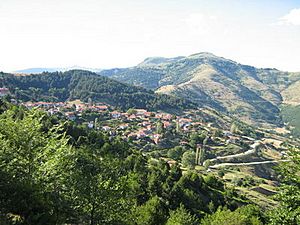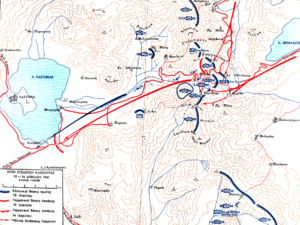Battle of Kleisoura Pass facts for kids
Quick facts for kids Battle of Kleisoura Pass |
|||||||
|---|---|---|---|---|---|---|---|
| Part of the German invasion of Greece | |||||||
 Kleisoura pass Greek plan of defense. |
|||||||
|
|||||||
| Belligerents | |||||||
| Commanders and leaders | |||||||
Lt. Col. Vasilios Mantzouranis (80th Reg.) |
|||||||
| Strength | |||||||
| unknown | 6,500 | ||||||
| Casualties and losses | |||||||
| heavy 1,000 captured (German claim) |
unknown | ||||||
The Battle of Kleisoura Pass was an important fight during World War II in Greece. It happened from the evening of April 13, 1941, until midday on April 14, 1941. This battle took place at a narrow mountain pass called Kleisoura, located between two mountains, Mt. Vitsi and Mt. Siniatsiko, in West Macedonia, Greece.
Greek soldiers from the 20th Infantry Division defended the pass against a strong German unit called the Leibstandarte SS Adolf Hitler. This pass was very important because it was on the main defensive line for the Allied forces (Greece and Britain). It also protected the escape route for the Greek army that was fighting against Italy in Albania. The battle ended with a German victory.
Why Was This Battle Important?
The German Advance and Greek Retreat
During World War II, Germany quickly moved through southern Yugoslavia. This made the Allied commanders, like General Wilson, worried. They had to change their plans and move their soldiers to a new defensive line. This was because the Germans might try to attack them from the side, through the Florina valley.
For the Greek soldiers on the eastern side of Mt. Vermion, this retreat was very difficult. They had to leave their well-prepared positions. They also had to march long distances at night to avoid air attacks. The weather was very bad, with snowstorms on Mt. Vermion, which made the soldiers tired and sad.
Problems with the Defense
A special unit called "Mackay Force" was supposed to slow down the German advance at Klidi Pass. However, they couldn't hold the Germans back for long enough. This meant that the Greek units didn't have enough time to reach and set up their new defensive spots. Some Greek soldiers were even cut off by the fast German advance and couldn't reach their assigned positions at all.
The Greek 20th Division was given the job of defending the Kleisoura and Vlasti passes. Because of the urgent situation, some battalions and engineers were sent ahead on April 10 to start preparing the defenses at Kleisoura Pass. When the Germans first attacked on April 13, most of the 20th Division had not yet arrived at the pass.
Who Fought in the Battle?
Greek Forces at Kleisoura Pass
Some Greek battalions, like I/87 and II/80, were already at the pass by April 10. However, the main part of the 80th Regiment arrived later, after a long night march. By the evening of April 13, the regiment had organized and taken its positions. But many soldiers were still arriving, and the battalions were not at full strength. They also had very few heavy weapons like machine guns and mortars. Many supplies, like ammunition and medical gear, had been left behind.
Between April 13 and 14, the Greek forces at the pass included:
- Infantry battalions I/87 and II/80, which were in relatively good shape.
- The 6th Positional Machine-gun battalion, but it had many shortages.
- Infantry battalions I/80 and III/80, which were tired and not at full strength.
Lieutenant Colonel Vasilios Mantzouranis was the main commander of the Greek forces during the battle.
German Forces
The German units fighting in the battle were part of the LSSAH, a very strong motorized infantry unit. They were led by Josef Dietrich. Their forces included several infantry battalions, a heavy infantry battalion, anti-aircraft units, and assault gun units. They also had engineers and reconnaissance units.
The Battle Begins
April 13: First Contact
To slow down the Germans, the Greeks destroyed parts of the road between Lehovo and Kleisoura. The first fighting began at 5:00 PM on April 13. German soldiers attacked the Greek line, especially battalion I/87. With strong effort and artillery support, the Germans pushed back the Greek I/87 battalion by 9:00 PM. Part of the battalion even surrendered.
After this, the Greek III/80 battalion, which was in reserve, moved to new positions at 11:00 PM. They fired on the positions the Germans had captured. The Germans did not continue their attack that night. However, artillery fire continued, which used up a lot of the Greek ammunition. About 50 Greek officers and soldiers were killed on April 13.
April 14: The Main Attack
At 4:30 AM, German artillery started heavily shelling the Greek positions. Then, German infantry attacked. They used smoke screens and intense machine-gun fire to cover their advance. Some attacks were supported by "tanks" (which were actually assault guns).
From their positions, the Germans fired on the side of the Greek 6th Machine-gun battalion. By 7:00 AM, the Greek artillery stopped firing because they had run out of ammunition. The German armored vehicles fired heavily on the Greek positions, and the Greeks had no weapons to fight them. German airplanes also flew over the battlefield constantly, which made the Greek soldiers even more discouraged.
Around 9:00 AM, the Greek 6th Machine-gun battalion's line began to break apart. Their machine guns were destroyed one by one, and soldiers started retreating. By 10:30 AM, they had run out of ammunition, and the rest of the battalion surrendered. The I/80 battalion to the south was not attacked as strongly, but its commander ordered a withdrawal to avoid being surrounded. As they retreated, they were attacked by German "tank" fire from close range, and most of the battalion surrendered by 10:45 AM.
The Greek commanders tried to reorganize their units west of the pass. They sent artillery to cover the infantry's retreat. However, the German artillery and air force scattered the Greek columns, and the fleeing soldiers overwhelmed the blocking units.
The Greek command ordered a counter-attack to retake the lost positions. But the Greek 20th Division was too scattered and weak to do this. They asked for help from other Allied forces, but the help did not arrive in time. The Germans continued their advance.
What Happened After the Battle?
The failure to hold Kleisoura Pass had serious consequences for the Greeks. The German advance directly threatened the main retreat route of the Greek army. Although the Greeks tried to stop the Germans again on April 15, they had to fight on open ground, which was less favorable than the pass.
The Greek forces suffered heavy losses, and the 80th Regiment was almost completely destroyed. The Germans claimed to have captured 1,000 prisoners. The Greek 20th Division was no longer able to fight effectively for the rest of the war.



